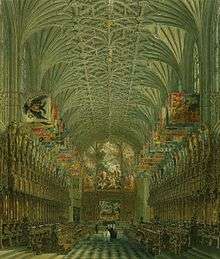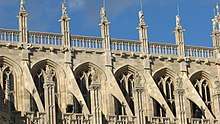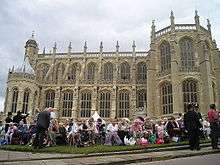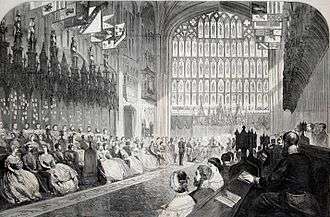St George's Chapel, Windsor Castle
St. George's Chapel at Windsor Castle in England is a chapel built in high-medieval Gothic style. It is both a Royal Peculiar, a church under the direct jurisdiction of the monarch, and the Chapel of the Order of the Garter. It is located in the Lower Ward of the castle.[1] St. George's castle chapel was originally founded in the 14th century by King Edward III and extensively enlarged in the late 15th century. It has been the scene of many royal services, weddings and burials. Windsor, England's premier castle, is the principal residence of the monarch.
| St. George's Chapel, Windsor Castle | |
|---|---|
| The Queen's Free Chapel of the College of St. George, Windsor Castle | |
.jpg) | |
| 51°29′02″N 0°36′24″W | |
| Location | Windsor |
| Country | England |
| Denomination | Church of England |
| Previous denomination | Roman Catholicism |
| Churchmanship | Anglo-Catholic |
| Website | www.stgeorges-windsor.org |
| History | |
| Status | Chapel |
| Dedication | St. George |
| Architecture | |
| Functional status | Active |
| Heritage designation | Grade I listed |
| Style | Gothic |
| Years built | 1475 |
| Completed | 1511 |
| Specifications | |
| Capacity | 800 |
| Administration | |
| Deanery | Dean and Canons of Windsor |
| Diocese | Jurisdiction: Royal Peculiar Location: Oxford |
| Clergy | |
| Dean | David Conner |
| Precentor | Martin Poll (Chaplain) |
| Canon(s) | Mark Powell (Steward) |
| Canon Treasurer | Hueston Finlay (Vice-Dean) |
| Laity | |
| Organist/Director of music | James Vivian |
| Music group(s) | Choir of St George's Chapel |
The running of the Chapel is the responsibility of the dean and canons of Windsor who make up the College of St. George. They are assisted by a Clerk, Verger and other staff. The Society of the Friends of St George's and Descendants of the Knights of the Garter, a registered charity, was established in 1931 to assist the College in maintaining the Chapel.
History

In 1348, King Edward III founded two religious colleges: St Stephen's at Westminster and St. George's at Windsor. The new college at Windsor was attached to the Chapel of St. Edward the Confessor which had been constructed by Henry III in the early thirteenth century. The chapel was then re-dedicated to the Blessed Virgin Mary, George the Martyr and Edward the Confessor, but soon became known only by its dedication to St. George.[2] Edward III also built the Aerary Porch in 1353–54. It was used as the entrance to the new college.

St. George's Chapel became the church of the Order of the Garter. A special service is still held in the chapel every June and is attended by members of the order. Their heraldic banners hang above the upper stalls of the choir, where they have a seat for life.
The period 1475–1528 saw a radical redevelopment of St. George's Chapel set in motion by Edward IV and continued by Henry VII under the supervision of his most esteemed counsellor, Sir Reginald Bray (later Chancellor of the Duchy of Lancaster), and by Henry VIII. The thirteenth-century Chapel of St. Edward the Confessor was enlarged into a cathedral-like space under the direction of Richard Beauchamp, Bishop of Salisbury, and the master mason, Henry Janyns. The Horseshoe Cloister was constructed for the new community of 45 junior members: 16 vicars, a deacon gospeller, 13 lay clerks, 2 clerk epistolers and 13 choristers. The Choir of St. George's Chapel continues to this day and numbers 20. The choristers are borders at St George's School, Windsor Castle. In term time they attend practice in the chapel every morning and sing Matins and the Eucharist on Sundays and Evensong throughout the week, except on Wednesdays.
St. George's Chapel was a popular destination for pilgrims during the late medieval period, as it was considered to contain several important burials: the bodies of John Schorne and Henry VI and a fragment of the True Cross held in a reliquary called the Cross of Gneth. It was seized from the Welsh people by Edward II after his conquest along with other sacred relics. These relics all appear to have been displayed at the eastern end of the south choir.
The Chapel suffered a great deal of destruction during the English Civil War. Parliamentary forces broke into and plundered the chapel and treasury on 23 October 1642. Further pillage occurred in 1643 when the fifteenth-century chapter house was destroyed, lead was stripped off the chapel roofs, and elements of Henry VIII's unfinished funeral monument were stolen. Following his execution in 1649, Charles I was buried in a small vault in the centre of the choir at St. George's Chapel which also contained the coffins of Henry VIII and Jane Seymour. A programme of repair was undertaken at St. George's Chapel after the Restoration.
During his life and reign, King George III was responsible for reigniting royal interest in Windsor Castle, which had been much overlooked after the House of Hanover came to the throne of the United Kingdom in 1714. On 12 August 1776 the Royal Family first attended the Sunday morning service at St George’s Chapel – which they called “the Cathedral”. George III was committed to St George’s Chapel; he inspired and in large part funded an extensive restoration of the Chapel from 1780-1790.
The reign of Queen Victoria saw further changes made to the structure of the chapel. The east end of the choir was reworked in memory of Prince Albert. The Lady Chapel, which had been abandoned by Henry VII, was completed. A royal mausoleum was completed underneath the Lady Chapel. A set of steps was built at the west end of the chapel to create a ceremonial entrance to the building.
By the early twentieth century, the bowing walls, cracked vaulting, decayed stone and stripped lead required urgent attention. In 1920 a much needed ten-year restoration project began at George’s Chapel, overseen by the consulting architect Sir Harold Brakspear.
In the 21st century, St. George's accommodates approximately 800 people for services and events.[1]

Queen's Beasts

On the roof of the chapel, standing on the pinnacles, and also on pinnacles at the sides, are seventy-six heraldic statues representing the Queen's Beasts, showing the Royal supporters of England. They represent fourteen of the heraldic animals: the lion of England, the red dragon of Wales, the panther of Jane Seymour, the falcon of York, the black bull of Clarence, the yale of Beaufort, the white lion of Mortimer, the greyhound of Richmond, the white hart of Richard II, the collared silver antelope of Bohun, the black dragon of Ulster, the white swan of Hereford, the unicorn of Edward III and the golden hind of Kent.[3]
The original beasts dated from the sixteenth century, but were removed in 1682 on the advice of Sir Christopher Wren. Wren had criticised the Reigate stone, the calcareous sandstone from which they were constructed. The present statues date from 1925 when the chapel was restored.[4][5]
Dean and Canons
Order of the Garter
Garter Service

Members of the Order of the Garter meet at Windsor Castle every June for the annual Garter Service. After lunch in the State Apartments (Upper Ward of the Castle), they process on foot in their robes and insignia, down to St. George's Chapel for the service. If new members are to be admitted, they are installed at the service. After the service, the members of the order return to the Upper Ward by carriage or car.

The Order frequently attended chapel services in the distant past, however they tailed off in the 18th century and were finally discontinued in 1805. The Garter Service was revived in 1948 by King George VI for the 600th anniversary of the founding of the Order and has since become an annual event.
Heraldry

After their installation, members are each assigned a stall in the chapel choir above which his or her heraldic devices are displayed.
A member's sword is placed beneath a helmet which is decorated with a mantling and topped with a crest, coronet or crown. Above this, a member's heraldic banner is hoisted emblazoned with his arms. A Garter stall plate, a small elaborately enamelled plate of brass, is affixed to the back of the stall displaying its member's name and arms with other inscriptions.
On a member's death, the sword, helmet, mantling, crest, coronet or crown, and banner are removed. A service marking the death of a late member must be held before the stall can be assigned to anyone else. The ceremony takes place in the chapel, during which the Military Knights of Windsor carry the banner of the deceased member and offer it to the Dean of Windsor, who places it on the altar.
The stall plates, however, are not removed. They remain permanently affixed to the stall, so the stalls of the chapel are emblazoned with a collection of plates of the members throughout history.
Chantries
St George's Chapel is among the most important medieval chantry foundations to have survived in England. The college was itself part of a medieval chantry, and there are a number of other chantry elements in the form of altars and small chapels in memory of various English monarchs and of a number of prominent courtiers, deans and canons. Special services and prayers would also be offered in memory of the founder. Henry VIII had originally intended another chantry to be set up in the chapel, despite the fact that his ecclesiastical changes led to the Reformation in England and the eventual suppression of chantries.
The much-admired iron gates in the sanctuary of the chapel as well as the locks on the doors of the chapel are the work of the medieval Cornish metalsmith John Tresilian.[6] The status of the college as a royal foundation saved it from dissolution at the Reformation. As a result, many of the smaller chantries within the chapel were preserved. These are the only remaining chantries of their kind in England which have never been suppressed.
Rutland Chantry

The Rutland Chantry chapel, forming the northern transept of St George's Chapel, was founded in 1491 in honour of Sir Thomas St Leger (c.1440–1483) and Anne of York, Duchess of Exeter (1439–1476).[7] Sir Thomas was Anne's second husband. She was the eldest surviving daughter of Richard Plantagenet, 3rd Duke of York, and thus elder sister of kings Edward IV (1442–1483, reigned 1461–1483) and Richard III (1452–1485, reigned 1483–1485). A monumental brass in memory of Anne of York and Sir Thomas survives on the east wall of the Rutland Chantry, the inscription of which records that the chantry was founded "with two priests singing forevermore":
"Wythin thys Chappell lyethe beryed Anne Duchess of Exetur suster unto the noble kyng Edward the forte. And also the body of syr Thomas Sellynger knyght her husband which hathe funde within thys College a Chauntre with too prestys sy’gyng for ev’more. On whose soule god have mercy. The wych Anne duchess dyed in the yere of oure lorde M Thowsande CCCCl xxv"
The chantry received its current name in honour of the earls of Rutland, descendants of Anne and Sir Thomas, their daughter, also Anne, married to George Manners, 11th Baron de Ros and their son, Thomas Manners, 1st Earl of Rutland. The tomb of George and Anne Manners is a prominent feature of the chantry. Their effigies are carved in English alabaster.[7]
The chantry comprises five panels which represent the Annunciation, the Visitation, the Adoration of the Magi, the Temptations of Christ in the wilderness and the Miracle at Cana. They were commissioned from embroiderer Beryl Dean and took five years to complete. Only one panel is normally on display to the public, but the others may be seen on request.[8]
Weddings

The chapel has been the site of many royal weddings, particularly of the children of Queen Victoria. They have included:
- Edward, Prince of Wales, and Princess Alexandra of Denmark in 1863 (later King Edward VII and Queen Alexandra respectively)
- Princess Helena and Prince Christian of Schleswig-Holstein-Sonderburg-Augustenburg in 1866
- Princess Louise and the Marquess of Lorne (later Duke of Argyll) in 1871
- Prince Arthur, Duke of Connaught and Strathearn and Princess Louise Margaret of Prussia in 1879
- Princess Frederica of Hanover and Baron Alphons von Pawel-Rammingen in 1880
- Prince Leopold, Duke of Albany and Princess Helena of Waldeck and Pyrmont in 1882
- Princess Marie Louise of Schleswig-Holstein and Prince Aribert of Anhalt in 1891
- Princess Alice of Albany and Prince Alexander of Teck (later Earl of Athlone) in 1904
- Princess Margaret of Connaught and Prince Gustaf Adolf of Sweden (later King of Sweden) in 1905
- Lady Helena Cambridge and Major John Gibbs, Coldstream Guards in 1919
- Anne Abel Smith and David Liddell-Grainger in 1957
- Lady Helen Windsor and Timothy Taylor in 1992
- Prince Edward, Earl of Wessex, and Sophie Rhys-Jones in 1999
- The union of Charles, Prince of Wales, and Camilla Parker Bowles in 2005 received a blessing from the Archbishop of Canterbury
- Peter Phillips and Autumn Kelly in 2008
- Prince Harry, Duke of Sussex, and Meghan Markle in 2018[9]
- Princess Eugenie of York and Jack Brooksbank in 2018
- Lady Gabriella Windsor and Thomas Kingston in 2019
Burials
The chapel has been the site of many royal funerals and interments. People interred in the Chapel include:
Altar
- George Plantagenet, 1st Duke of Bedford, on 22 March 1479; a son of Edward IV and Elizabeth Woodville
- Mary of York, in 1482; a daughter of Edward IV and Elizabeth Woodville
- Edward IV, King of England (1461–1470; 1471–1483), in 1483
- Henry VI, King of England (1422–1461; 1470–1471), reburied from Chertsey Abbey in 1484
- the coffins of two unidentified children suggested to be the Princes in the Tower, sons of Edward IV and Elizabeth Woodville
- Elizabeth Woodville, wife of Edward IV (1464–1483), on 12 June 1492
- Princess Louise of Saxe-Weimar, niece of Queen Adelaide, in 1832
- Edward VII, King of the United Kingdom (1901–1910), on 20 May 1910
- Alexandra of Denmark, wife of Edward VII (1863–1910), on 28 November 1925
Choir
- Jane Seymour, Queen of England, in 1537
- Henry VIII, King of England and Ireland, in 1547
- Charles I, King of England, Scotland and Ireland, in 1649
- Stillborn son of Queen Anne (last monarch of the House of Stuart), in 1698.
Royal Vault
- Princess Amelia of the United Kingdom in 1810
- Princess Augusta, Duchess of Brunswick-Wolfenbüttel in 1813
- Princess Charlotte of Wales in 1817
- Stillborn son of Princess Charlotte in 1817.
- Charlotte of Mecklenburg-Strelitz, Queen of the United Kingdom, in 1818
- Stillborn daughter of Ernest Augustus, King of Hanover in 1818
- George III, King of the United Kingdom, in 1820
- Prince Edward, Duke of Kent and Strathearn in 1820
- Prince Alfred of Great Britain (reburial) in 1820
- Prince Octavius of Great Britain (reburial) in 1820
- Princess Elizabeth of Clarence in 1821
- Prince Frederick, Duke of York and Albany in 1827
- George IV, King of the United Kingdom, in 1830
- William IV, King of the United Kingdom, in 1837
- Princess Augusta Sophia of the United Kingdom in 1840
- Adelaide of Saxe-Meiningen, Queen of the United Kingdom, in 1849
- Prince Harald of Schleswig-Holstein, son of Princess Helena of the United Kingdom
- George V, King of Hanover, in 1878
- Princess Mary Adelaide of Cambridge in 1897
- Francis, Duke of Teck in 1900
- Princess Frederica of Hanover in 1926
- Prince Adolphus, Duke of Cambridge (reburial) in 1930
- Princess Augusta of Hesse-Kassel (reburial) in 1930
Near West Door
- George V, King of the United Kingdom, in 1936
- Mary of Teck, Queen of the United Kingdom, in 1953
King George VI Memorial Chapel
- George VI, King of the United Kingdom, died 1952. Interred 26 March 1969 following its construction.[10]
- Princess Margaret, Countess of Snowdon (ashes), in 2002
- Elizabeth Bowes-Lyon, Queen of the United Kingdom, in 2002
Albert Memorial Chapel
- Baroness Victoria von Pawel-Rammingen, daughter of Princess Frederica of Hanover, in 1881
- Prince Leopold, Duke of Albany, in 1884
- Prince Albert Victor, Duke of Clarence, in 1892
Gloucester Vault
- Prince William Henry, Duke of Gloucester and Edinburgh, in 1805
- Maria, Duchess of Gloucester and Edinburgh, in 1807
- Prince William Frederick, Duke of Gloucester and Edinburgh, in 1834
- Princess Sophia of Gloucester, in 1844
- Princess Mary, Duchess of Gloucester and Edinburgh, in 1857[11]
Other
- William, 1st Baron Hastings (1431–1483), a nobleman and close friend of King Edward IV; in the north aisle of St George's Chapel, next to Edward IV.
- Anne St Leger, Baroness de Ros (1476 – 21 May 1526) and her husband George Manners, 11th Baron de Ros (22 August 1465 – 23 October 1513) in the private Rutland Chapel[12]
- Charles Brandon, 1st Duke of Suffolk, in 1545
- Christopher Villiers, 1st Earl of Anglesey, in 1631
- Henry Somerset, 1st Duke of Beaufort (1629–1700) and his ancestors in the private Beaufort Chapel; the original monument by Grinling Gibbons was moved to St Michael and All Angels Church, Badminton, in 1878.
- Very Revd Dr Penyston Booth (1681–1765), Dean of Windsor
- Dejazmatch Alemayehu Tewodros, son of Emperor Tewodros II of Ethiopia, on 21 November 1879
In literature
- Wenceslaus Hollar. View and Ground Plan of St. George's Chapel, Windsor ca. 1671.[13][14][15]
- John Henry Le Keux. St. George's Chapel, Windsor. Ground Plan 1810. Engraved after a plan by F. Mackenzie, published in Britton's Architectural antiquities of Great Britain, 1807. Copper-engraved antique plan.[16][17]
See also
- Choir of St George's Chapel, Windsor Castle
- Dean of Windsor
- Dean and Canons of Windsor
- Francis Eginton, artist, painted the arms of the knights of the Garter for two Gothic windows in the stalls.
- List of Knights and Ladies of the Garter
- List of Ladies of the Garter
- Order of the Garter
- Saint George: Devotions, traditions and prayers
- The Society of the Friends of St George's and Descendants of the Knights of the Garter
- Windsor Castle
- Historical monographs relating to St. George's Chapel, Windsor Castle
- Royal Chapel of All Saints, a chapel in Windsor Great Park closely connected with St George's Chapel
References
- Notes
- "Harry and Meghan to wed at Windsor in May". BBC News. 28 November 2017. Retrieved 28 November 2017.
- P H Ditchfield and William Page, eds. (1907). "Collegiate churches: Windsor (St George's chapel)". A History of the County of Berkshire: Volume 2. Victoria County History. p. 106.CS1 maint: uses editors parameter (link)
- "Windsor Royal Beasts on St George's Chapel roof". Wordpress. Retrieved 10 October 2014.
- London, H. Stanford (1953). “The” Queen's Beasts: An Account with New Drawings of the Heraldic Animals Witch Stood at the Entrance to Westminster Abbey on the Occasion of the Coronation of Her Majesty Queen Elizabeth II., 2. June 1953. Newman Neame. p. 15.
- "Sir Frederick Minter". The Times. 15 July 1976. p. 19.
- Blackburne, Harry W. (2008). The Romance of St. George's Chapel, Windsor Castle. Wildside Press. pp. 14–. ISBN 978-1-4344-7428-5.
- Eleanor Cracknell (15 July 2011). "The Rutland Chantry". College of St George. Retrieved 19 May 2018.
- "Beryl Dean Panels". College of St George. Retrieved 28 October 2019.
- Yeginsu, Ceylan (2 March 2018). "Prince Harry and Meghan Markle Invite Members of Public to Wedding Day". The New York Times. ISSN 0362-4331. Retrieved 5 March 2018.
- "Royal Burials in the Chapel since 1805". College of St George. 2017. Retrieved 19 May 2018.
- "Royal Burials in the Chapel by location". College of St George. 2017. Retrieved 19 May 2018.
- "The Roos Monument in the Rutland Chantry Chapel". College of St George. 10 September 2010.
- "View and Ground Plan of St. George's Chapel, Windsor - Wenceslaus Hollar". 21 June 2016.
- "View and Ground Plan of St. George's Chapel, Windsor - Wenceslaus Hollar". 8 May 2015.
- "View and Ground Plan of St. George's Chapel, Windsor - Wenceslaus Hollar". 21 June 2016.
- "Picture" (JPG). www.antiqueprints.co.
- "Free stock images for genealogy and ancestry researchers". www.ancestryimages.com.
- Sources
- Begent, Peter J.; Chesshyre, Hubert; Chesshyre, D. H. B.; Jefferson, Lisa (1999). The most noble Order of the Garter: 650 years. Spink.CS1 maint: ref=harv (link)
- Keen, Laurence; Scarff, Eileen, eds. (2002). Windsor: medieval archaeology, art and architecture of the Thames Valley. British Archaeological Association.CS1 maint: ref=harv (link)
- Saul, Nigel, ed. (2005). St George's Chapel, Windsor, in the Fourteenth Century. Boydell Press. ISBN 978-1-84383-117-4.CS1 maint: ref=harv (link)
- Richmond, Colin; Scarff, Eileen, eds. (2001). St Georges Chapel, Windsor, in the late Middle Ages. Windsor: Maney Publishing. ISBN 978-0-9539676-1-2.CS1 maint: ref=harv (link)
External links
| Wikimedia Commons has media related to St. George’s Chapel, Windsor Castle. |